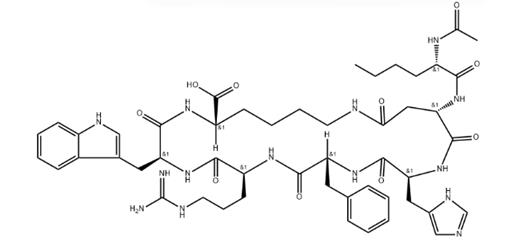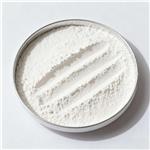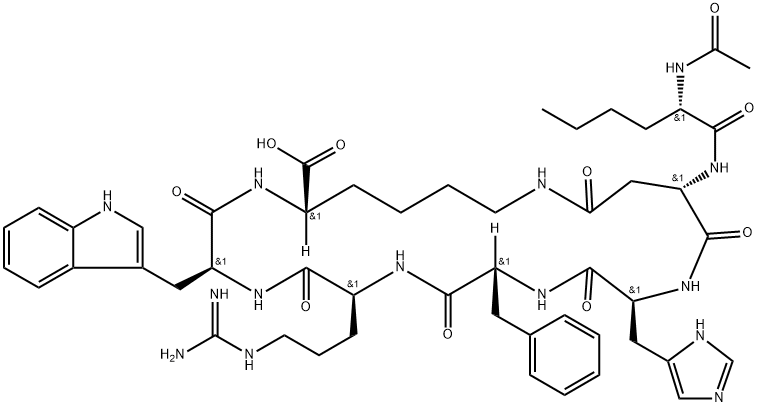Exploring Bremelanotide: The Science Behind the Promising Drug
Mar 27,2024
General description
Bremelanotide, a peptide drug also known by its trade name PT-141, has emerged as a notable contender in this pursuit. With its potential to address sexual dysfunction, particularly in women, Bremelanotide has garnered significant attention from both the medical community and the public.
Understanding Bremelanotide
Bremelanotide belongs to a class of drugs known as melanocortin receptor agonists. These peptides interact with melanocortin receptors in the brain, modulating various physiological functions, including sexual behavior. Unlike traditional treatments for sexual dysfunction, such as Viagra, which primarily targets blood flow, Bremelanotide acts centrally on the nervous system, influencing desire and arousal[1].

Figure 1 Structural formula of Bremelanotide
Mechanism of Action
The primary mechanism of Bremelanotide revolves around its agonistic activity at the melanocortin receptors, particularly MC4R (Melanocortin 4 Receptor). Activation of MC4R triggers a cascade of neural events that ultimately enhance sexual arousal. Studies suggest that Bremelanotide may also affect other neurotransmitter systems, such as dopamine and serotonin, further augmenting its effects on sexual function.
Clinical Applications
Initially investigated as a potential treatment for male erectile dysfunction, Bremelanotide has garnered more attention for its efficacy in addressing female sexual arousal disorder (FSAD) and hypoactive sexual desire disorder (HSDD). Clinical trials have demonstrated promising results, showing significant improvements in both subjective and objective measures of sexual function among women receiving Bremelanotide treatment.
Furthermore, Bremelanotide's non-invasive administration, typically through subcutaneous injection, offers a convenient and discreet option for patients. Unlike some other medications for sexual dysfunction, Bremelanotide does not require precise timing relative to sexual activity, making it a more flexible choice for patients.
Challenges and Future Directions
Despite the promising potential of Bremelanotide in addressing sexual dysfunction, there are multifaceted challenges that warrant attention for its widespread adoption and optimal efficacy. Foremost among these challenges is the need to address the occurrence of side effects reported during clinical trials, such as nausea and headache. While these side effects are generally considered mild to moderate, their prevalence could hinder patient adherence and satisfaction with treatment. Thus, there is an imperative to explore strategies for minimizing these adverse effects without compromising the therapeutic benefits of Bremelanotide.
Furthermore, as with any medication, understanding the long-term safety profile of Bremelanotide is paramount. While initial trials provide valuable insights into its short-term effects, comprehensive studies assessing its safety and efficacy over extended periods are necessary. This is particularly crucial in specific patient populations, including those with underlying medical conditions or individuals concurrently taking medications that may interact with Bremelanotide. Such investigations can help delineate the risk-benefit profile of Bremelanotide and guide its appropriate use in clinical practice.
Looking forward, the evolution of Bremelanotide hinges on continued research efforts aimed at refining various aspects of its administration and delivery. Optimizing its formulation to enhance stability, bioavailability, and duration of action can contribute to improved patient outcomes and treatment adherence. Similarly, exploring alternative dosing regimens and delivery methods, such as intranasal or transdermal formulations, could offer greater convenience and comfort for patients while maintaining therapeutic efficacy.
Moreover, as our understanding of the neurobiological mechanisms underlying sexual function expands, there is an opportunity to identify novel therapeutic targets beyond the melanocortin system. By elucidating the intricate interplay of neurotransmitters, hormones, and neural circuits involved in sexual arousal and desire, researchers may uncover new avenues for intervention that complement or enhance the effects of Bremelanotide. This broader perspective on sexual medicine holds the promise of developing more tailored and effective treatments for individuals with diverse presentations of sexual dysfunction.
In conclusion, while Bremelanotide represents a significant advancement in sexual medicine, its journey toward widespread clinical use is accompanied by several challenges and opportunities. Addressing the occurrence of side effects, elucidating long-term safety considerations, and refining its formulation and delivery methods are essential steps in maximizing its therapeutic potential. Moreover, an ongoing exploration of neurobiological pathways may unveil innovative strategies for improving sexual function beyond the scope of current treatments. By navigating these challenges with diligence and innovation, Bremelanotide can fulfill its promise as a transformative therapy for individuals grappling with sexual dysfunction, ushering in a new era of enhanced sexual health and well-being[2].
References
[1]Pfaus J, Giuliano F, Gelez H. Bremelanotide: an overview of preclinical CNS effects on female sexual function[J]. The journal of sexual medicine, 2007, 4(Supplement_4): 269-279.
[2] Clayton A H, Lucas J, Jordan R, et al. 221 Bremelanotide: A review of its neurobiology and treatment efficacy for HSDD[J]. The Journal of Sexual Medicine, 2017, 14(Supplement_1): S62-S63.
- Related articles
- Related Qustion
- What is the efficacy and safety of Bremelanotide in the treatment of male sexual dysfunction? Nov 28, 2024
Bremelanotide is a melanocortin receptor agonist that has been approved by the FDA for the on-demand treatment of premenopausal women with systemic, acquired hypoactive sexual desire disorder (HSDD).
- Bremelanotide for Female Hypoactive Sexual Desire Disorder Nov 14, 2023
Bremelanotide received FDA approval in June 2019 for the treatment of acquired, systemic HSDD in premenopausal women.
- Uses and side Effects of Bremelanotide Apr 19, 2022
Bremelanotide injection is used to treat hypoactive sexual desire disorder (HSDD) in premenopausal women who previously had no problems with sexual desire and that occurs in any type of stimulation, situation, or partner.
Supplementation with pyridoxal 5'-phosphate monohydrate can synthesize neurotransmitters such as dopamine and serotonin, maintaining a healthy nervous system.....
Nov 4,2025Biochemical EngineeringPotassium benzoate is a widely used preservative in the food and beverage industry, playing an important role in everything from food to personal care products.....
Dec 10,2024Inorganic saltsBREMELANOTIDE
189691-06-3You may like
- PT-141
-

- $0.00 / 1Box
- 2025-12-14
- CAS:
- Min. Order: 1Box
- Purity: 0.99
- Supply Ability: 10tons
- 189691-06-3
-

- $1.00 / 10g/ml
- 2025-12-14
- CAS:189691-06-3
- Min. Order: 1kit
- Purity: 99.9%
- Supply Ability: 100KG
- PT-141
-

- $1.00 / 1kit
- 2025-12-14
- CAS:189691-06-3
- Min. Order: 1kit
- Purity: 99.9%
- Supply Ability: 200






